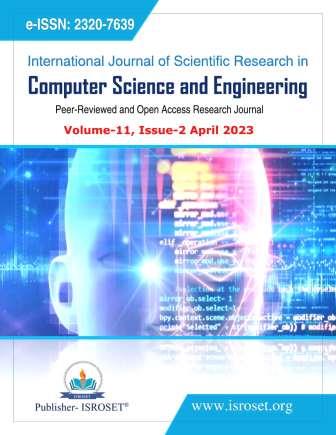Effective Machine Learning Classifiers for Intrusion Detection in Computer Network
Keywords:
CART, Chi-Square, Computer Networks, IDS, KNN, MLR, NSL, KDD, CUPAbstract
Cyber security has finally become inevitable due to the increase in use of internet and computer networks. This has given access to cyber-attacks in the network services. However, Intrusion detection systems (IDSs) have been incorporated into networks so as to overcome these huge challenges. IDSs are capable of identifying malicious or abnormal activity in the network and draw the attention of the network administrator to it. Furthermore, approaches based on machine learning (ML) are able to increase IDS effectiveness. In this study, the NSL-KDD CUP dataset was used to develop and validate three individual models using three supervised machine learning algorithms: Classification and Regression Tree (CART), Multinomial Logistics Regression (MLR), and K-Nearest Neighbor (KNN).Data preprocessing and Feature Selection was initiated in order to remove outliers and imbalance in the dataset and optimally select the best feature to avoid data redundancy. Performance evaluation was conducted on each of the model developed with the following metrics as training time, precision accuracy, sensitivity, , f-Score and specificity, The evaluation`s final findings indicate that KNN is the most effective classifier, with a classification accuracy of 99.38% and a training time of 13.64 seconds with the lowest error rate (0.006161), making it the best model and encouraging further study.
References
Kizza, Joseph. Guide to Computer Network Security. 10.1007/978-3-319-55606-2,2017.
Jyothsna, V., & Munivara Prasad, K. (2020). Anomaly-Based Intrusion Detection System. Computer and Network Security. doi: 10.5772/intechopen.8228, 2017
Abduvaliyev, A. S. K. Pathan, J. Zhou, R. Roman, and W. C. Wong,(2021) “On the vital areas of intrusion detection systems in wireless sensor networks,” IEEE Communications Surveys Tutorials, vol. 15, no. 3, pp. 1223–1237, 2017
Olofintuyi, S.S. & Omotehinwa, T.O. Performance Evaluation of Supervised Ensemble Cyber Situation Perception Models for Computer Network. Computing, Information Systems, Development Informatics & Allied Research Journal. Vol 11 No 2, Pp 1-.14. DOI Affix - https://doi.org/ 10.22624/AIMS/CISDI/V12N1P1. Available online at www.computing-infosystemsjournal.info, 2021
Ahanger, A.S., Khan, S.M., & Masoodi, F. An Effective Intrusion Detection System using Supervised Machine Learning Techniques. 2021 5th International Conference on Computing Methodologies and Communication (ICCMC), 1639-1644, 2021
Afzal Ahmad, Mohammad Asif, Shaikh Rohan Ali "Review Paper on Shallow Learning and Deep Learning Methods for Network security." International Journal of Scientific Research in Computer Science and Engineering 6.5 (2018): 45-54.
Maimuna Yusuf Ma`aji and Muhammad Sirajo Ali,Models Comparison Based On Intrusion Detection Using Machine Learning,Sule Lamido University Journal of Science &Technology Vol. 6No. 1&2, pp. 74-86https://doi.org/10.56471/slujst.v6i.358.Online ISSN: 2736-0903 PrintISSN: 2736-089Xwww.slujst.edu.ng.,2023
.Iram Abrar, Zahrah Ayub, Faheem Masoodi and Kashmir, Jammu & Kashmir ‘‘A Machine Learning Approach for Intrusion Detection System on NSL-KDD Dataset’’ Proceedings of the International Conference on Smart Electronics and Communication (ICOSEC 2020) IEEE Xplore Part Number: CFP20V90-ART; ISBN: 978-1-7281-5461-9, 2020
Soe,Y.N; Santosa P.I.; and Hartanto,R. ( "DDoS Attack Detection Based on Simple ANN with SMOTE for IoT Environment," 2019 Fourth International Conference on Informatics and Computing (ICIC), Semarang, Indonesia, pp. 1-5, doi: 10.1109/ICIC47613.2019.8985853,2019
Diro AA, Chilamkurti N. Distributed attack detection scheme using deep learning approach for Internet of Things. Future Generation Computer Systems 82:761–768 DOI 10.1016/j.future.2017.08.043.
J. Dhiviya Rose, Isha Mittal, Ramya Mihir "Efficient and Simple Machine Learning-based Malware and Trojan Identification Tool." International Journal of Scientific Research in Computer Science and Engineering 10.2 (2022): 64-68.
Elbasiony M., Reda, et al. “A hybrid network intrusion detection framework based on random forests and weighted k-means,” Ain Shams Engineering Journal, Vol. 4, No. 4, pp.753-762, 2020
Roopak, M., Tian G.Y and Chambers J."An Intrusion Detection System Against DDoS Attacks in IoT Networks," 10th Annual Computing and Communication Workshop and Conference (CCWC), Las Vegas, NV, USA, 2020, pp. 0562-0567, doi: 10.1109/CCWC47524.2020.9031206, 2020
Eduardo K. Viegas, Altair O. Santin and Luiz S. Oliveira. “Toward a reliable anomaly-based intrusion detection in real-world environments,” Computer Networks, Vol. 127, pp. 200-216,2017
T. Parvin, T. Nasrin, J. Khatun, M. Chatterjee "Predictive Machine Learning Model for Detection and Classification of Diabetes." International Journal of Scientific Research in Multidisciplinary Studies 7.9 (2021):11-17.
Dhakne, A.R., Chatur, P.N. A Comprehensive Survey on Intrusion Detection Systems in Wireless Sensor Network. In: Unal, A., Nayak, M., Mishra, D.K., Singh, D., Joshi, A. (eds) Smart Trends in Information Technology and Computer Communications. SmartCom 2016. Communications in Computer and Information Science, vol 628. Springer, Singapore. https://doi.org/10.1007/978-981-10-3433-6_65,2016
Mehmood, T., &Rais, H. B. M. “Machine learning algorithms in context of intrusion detection.” International Conference on Computer and Information Sciences (ICCOINS): 369-373, 2016
Idowu, I. R., Adeniji, O. D., Okewale, K., &Alabi, F. A. Detection of Cyberbullying in the Social Media Space using Maximum Entropy and Convolutional Neural Network. Journal of Engineering Research and Reports, 23(2), 40-48. https://doi.org/10.9734/jerr/2022/v23i217595, 2022
Alqahtani, H., Sarker, I. H., Kalim, A., Minhaz Hossain, S. M., Ikhlaq, S., & Hossain, S. Cyber intrusion detection using machine learning classification techniques. In N. Chaubey, S. Parikh, & K. Amin (Eds.), Computing Science, Communication and Security: First International Conference, COMS2 2020 Gujarat, India, March 26–27, , Revised Selected Papers (pp. 121-131). (Communications in Computer and Information Science; Vol. 1235 CCIS). Springer, Springer Nature. https://doi.org/10.1007/978-981-15-6648-6_10, 2020
OOthman, S. M., Ba-Alwi, F. M., Alsohybe, N. T., & Al-Hashida, A. Y. “Intrusion detection model using machine learning algorithm on Big Data environment. ”Journal of Big Data 5(1): 34.201
Awotunde J.B.,Ajagbe S.A, IdowuI.R., Ndunagu J.N. .An Enhanced Cloud-IoMT-based and Machine Learing for effective COVID-19 Diagniosis System.In :Al-TurjmanF.;Nayyar A.., Devi A., Shukla P.K.(eds) Intelligence of Things: AI-IoT Based Critical-Applications and Innovations. Springer,Cham. https://doi.org/10.1007/978-3-030-82800-4_3, 2021.
Downloads
Published
How to Cite
Issue
Section
License

This work is licensed under a Creative Commons Attribution 4.0 International License.
Authors contributing to this journal agree to publish their articles under the Creative Commons Attribution 4.0 International License, allowing third parties to share their work (copy, distribute, transmit) and to adapt it, under the condition that the authors are given credit and that in the event of reuse or distribution, the terms of this license are made clear.







